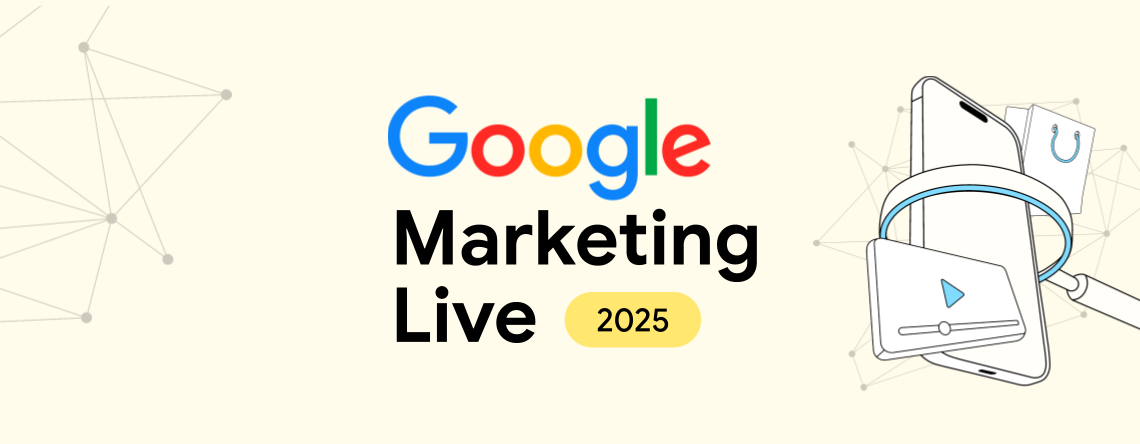New features that empower marketers & unlock further performance with AI
Artificial Intelligence is embedded in our lives today – changing how we communicate, how we research, and how we make decisions. Sometimes it’s a solution consumers seek out, like when they turn to Google’s new AI Mode to brainstorm. Other times it’s an ambient experience built into a platform, seamlessly meeting the person where they are.
At Google Marketing Live 2025, Google’s announcements centered around making AI more powerful, transparent, and accessible for advertisers. Some solutions were built for less advanced advertisers, making it easier for them to harness the power of modern search automation. Others were created specifically for the Google Ads power user, providing functionality that Brainlabs (and the industry at large) has been requesting. All of them are built around connecting with the right audience and moving them from discovery to decision across multiple experiences, from searching to scrolling to shopping to streaming.
The new features announced during the GML livestream on Wednesday, May 21 were focused around three themes:
- Supercharging search ads with AI
- Connecting curiosity and conversion on YouTube
- Providing advertisers increased transparency & security across measurement
Supercharging Search Ads with AI
Search shows no signs of slowing down. Last year Google processed five trillion searches globally, and signed in users 18-24 are searching more than any other age group. Even as the consumer journey becomes more complex, with more entry points and sources to find answers, Google Search remains the touchstone where people seek answers to each spark of curiosity.
AI Max for Search Campaigns
It’s easy to see how AI has transformed the search results page, with AI Overviews surfacing quick answers to even complex queries (and it’s kind of incredible that it’s only been a year since AIOs launched at Google I/O 2024). This year at I/O Google announced even more AI-powered solutions for consumers, including virtual try-on for clothing and agentic shopping.
AI has also transformed Google Ads, and this year Google is giving advertisers tools built to further unlock performance via AI – for advanced adopters of Google’s solutions, and also for beginners who have yet to leverage Google’s suite of AI-powered ad solutions.
Starting today, advertisers around the world can turbocharge their paid search campaigns with AI Max for Search, which has just released in open beta testing. This suite of AI-powered targeting and creative enhancements promises to boost performance by reaching ready-to-convert users at the right time, for the right search – and advertisers can enable it with just one click..
Google’s testing shows that advertisers upgrading from exact/phrase match types by utilizing AI Max have seen conversion lifts of up to 27% due to better search term matching and asset optimizations. The search term matching will take Dynamic Search Ads (DSA) to the next level by using AI to learn from every search and improve its keywordless targeting. Asset optimization follows right behind by taking the AI learnings and predicting the best ad copy and landing page for the campaign goals.
Once activated, AI Max will provide new reporting views as well. For the first time in many years a complete user journey will be visible with the combined search term, headline, and URL. While AI is in the forefront running the campaign, advertisers can review the real-time data and better understand the search intent and interest driving business success.
Even advertisers who are already utilizing the features AI Max implements can still expect small but measurable improvements from enabling this feature. With the right-sized budget to support such an increase in performance, AI Max can be the simplest way to benefit from the latest advancements Google has released over the last few years.
As seen from Performance Max and Demand Gen, Google is rearranging their product portfolio to leverage AI advancements to better align advertiser offerings with user interest. AI Max for Search is no different, and the initial results are a reason for all advertisers to test this feature – regardless of their current level of search campaign sophistication.
Smart Bidding Exploration
For almost a decade smart bidding has been the bedrock of any Google Ads account. Every single one of Google’s AI product releases have been predicated upon the foundation of auction-level bidding; and from an advertiser perspective, bidding functionality has remained relatively unchanged throughout that time, with the majority of bidding innovations being buried away in Google’s back-end.
Smart Bidding Exploration (SBE) enables advertisers to serve ads to new high value searches. It’s exciting because it represents the first major, in-platform change to bidding in many years, offering a new mechanism through which advertisers will be able to communicate their commercial objectives to Google Ads, and to signal their appetite for growth vs. efficiency. The previews that we saw at GML hinted at the existence of a sliding scale to allow advertisers to fine tune how aggressively they’d like SBE to chase after previously untapped search queries.
It’s important to note that SBE was first made available in beta in 2024. While this announcement may not on the face of it come with the same inherent va-va-voom as some of Google’s other product launches, the fact that Google chose SBE as one of their hero releases demonstrates their confidence in the product from their early-stage testing.
Finally, it’s not hard to see how Smart Bidding Exploration could tie into Google’s ongoing rollout of Ads in AI Overviews. For users, AIOs are most likely to trigger on exploratory and never-before-seen search queries. It’s exactly these sorts of low-volume queries that Search Bidding Exploration promises to connect advertisers to.
Connecting Curiosity and Conversion on YouTube
Video is the medium of modern marketing. It’s where people go to feel inspired, seek opinions, and research products. Consumers are watching an average of 90 million hours of shopping videos daily – content from brands, but also content from influencers. This year Google announced new features to more closely connect curiosity and purchase, streamlining the experience on mobile and across devices.
Google announced their plans to scale ads placed in AI generated responses. Ads in AI Overviews will expand beyond mobile to begin serving on desktop, and Google will begin testing showing ads in their new AI Mode search experience. These ads will appear at the bottom of the AI response, providing users with next step engagement options based on their initial prompt. With Gemini prompts being 2-3 times longer than traditional keyword searches, Google will leverage this additional user input to better predict not only what people want, but also why.
YouTube Shoppable Masthead
Google’s other big video announcement this year is also focused on driving conversions. The premium YouTube masthead placement now features shoppable functionality. This is a premium placement, so brands should look to test during tentpole events relevant to their vertical – or at times when they’re running an extremely compelling promotion. In addition to evaluating direct conversions, we also recommend brands leveraging this placement to also measure new customer acquisition – it can be a powerful source for driving new purchasers.
Shoppable CTV
Over the past year, ads showing via YouTube on CTV screens drove over one billion conversions around the world. Google is expanding the direct response capabilities of YouTube via an interactive shopping experience that enables viewers to quickly purchase by using QR codes or a “send to phone” option, smoothly moving from ad to interactive experience across devices.
This feature is, unsurprisingly, powered by Google Merchant Center (GMC) product feeds, so the first step advertisers should take to get the most out of it is to ensure their feeds are not just compliant with GMC policies, but also optimized. Look for Shoppable CTV features to roll out to Demand Gen and Performance Max campaigns later this year.
Creator Partnerships Hub
Google is making it easier for advertisers to identify and leverage creators on YouTube. The Creator Partnerships Hub allows marketers to search by keyword and genre, surfacing relevant creators along with all of their metrics & estimated partnership cost. Marketers can easily identify top performing creator content to amplify via advertising, and then track organic and paid performance side by side.
This hub feels like the ideal starting point for advertisers who want to launch influencer campaigns on YouTube, regardless of their level of previous experience in the Influencer marketing space.
Measurement: Increased Transparency & Security
It wasn’t just bidding and video solutions that saw some exciting announcements. Google shared several very intriguing announcements around their evolving measurement suite. The general themes were transparency and automation – providing more data and offering more streamlined ways to access it utilizing AI agents to process complex questions and surface answers in seconds..
In order to understand what’s driving actual business growth – not just channel performance – marketers need a modern measurement toolkit that delivers data and empowers them to surface insights. These insights provide the fuel advertisers have been seeking to further refine their AI-enabled marketing and content strategies.
Let’s break the announcements down, in order of Brainlabs’ perceived significance.
Easier, Faster Incrementality Testing
Incrementality testing as a concept has been around for a long time. However, the challenge for many has always been around the practicalities of running such tests. Lengthy planning periods, complex data setups – not to mention the large budgets that have historically been required to derive significant results – have meant that incrementality testing was an unattainable tool for many advertisers.
Google’s new improvements to incrementality testing empower all advertisers to run tests that clearly surface the incremental value of their advertising spend across Google Ads. Google has not only provided a new Bayesian methodology that dramatically increases the likelihood of obtaining statistically significant outcomes, but they’ve enabled advertisers to run these lift studies across all Google Ads campaign types. And that’s not all: they’ve also lowered the minimum required budget by a factor of 20, from $100,000, down to only $5,000 per test.
The fact that incrementality testing is now becoming a standard part of every paid search marketer’s toolkit, is a huge step forward for the industry. Every single advertiser should be thinking about how they can use these tests to better understand (and ultimately, optimize) their investment in media.
Channel-Level Reporting is coming to Performance Max
…And with this announcement, search marketers around the globe breathed a collective sigh of relief. It’s fair to say there was probably no more universally-welcomed announcement this year than channel-level reporting in Performance Max campaigns, which the industry has been banging on Google’s door about ever since the campaign type first debuted in 2021.
This update is crucial because, up until now, only Google has had true visibility into the dynamics at play between each of the different components of Performance Max inventory. The paid search community has to some extent had to take it on trust that each of the additional media placements have been driving incremental value for their business. Making this data accessible for all will undoubtedly boost confidence in PMax at large, and will also provide advertisers with far greater levels of understanding of how they should be showing up within those non-Search environments.
This data will be surfaced several ways, including a very snazzy visualization graph and a channel distribution table with extremely detailed metrics. Advertisers will be able to analyze historic Performance Max performance going back to at least November 17, 2024.
This is big. Make no mistake about it: there will be considerable first-mover advantages up for grabs to those advertisers who take the initiative to analyze and understand the implications of these new insights, before their competition do.
Confidential Matching
Last year Google announced their confidential matching program to allow advertisers to use a Trusted Execution Environment to manage their first party customer match lists. Today, Google announced a major expansion of the program that provides 11% more signals through the Google Tag Gateway, unlocking even deeper insights.
With the power of Google Tag Gateway and confidential computing, advertisers can improve the measurement of their website and app performance with no retagging required.
Data Manager API
AI powered by data. No matter how powerful Google’s AI-powered advertising features are, they always become more powerful when fueled by a brand’s first-party data. But connecting that data to advertising platforms is complex, cumbersome, and confusing.
Enter Google’s Data Manager API. It offers a one-stop shop to get online and offline data working harder while also ensuring that every piece of data is secure by default.
This new solution enables advertisers to connect conversion and audience data from their website, apps, and CRM lists to Google Ads in order to steer AI-powered automation to optimize toward transformative business results. It consolidates multiple ingestion APIs into a single entry point – making it much easier for advertisers to set up.
Everyone using Google Ads should make the time to learn about this solution and update their roadmaps to utilize it. Advertisers who are already feeding data into Google’s advertising systems can simplify their connections to Google Ads, GA4, and GMP solutions. Advertisers who have been unable to set up these data transfers should consider using Data Manager API. It’s not only simple, it provides confidential matching so it’s extremely safe and secure.
Attributed brand searches from YouTube
Google are also releasing greater insights for YouTube buyers, with in-built reporting into any brand searches that occurred after the view of a YouTube ad. Through this feature, it will essentially be possible to configure “user performed a branded search” as a conversion action for campaigns on YouTube.
Other Announcements
Google made several more announcements at GML2025:
- The Marketing Advisor AI-powered agent, a comprehensive way for marketers to diagnose issues, find opportunities, and take action.
- The incredibly powerful Asset Studio in Google Ads, their unified creative destination – a welcome consolidation for managing and syncing AI-generated creative across Google Ads placements.
- Demand Gen Audience exclusions, which enable advertisers to lean into the strength of these campaigns – driving engagement and conversions with audiences who have no pre-existing relationship with the brand.
- The Commerce Media Suite for retailers and brands – a solution to enable the seamless sharing of data between manufacturers and sellers
Personal, proactive, powerful – and empowering for advertisers
AI is giving search superpowers. Google held their annual I/O event the day before Google Marketing Live this year, and they shared dozens of announcements showcasing ways they are making their AI offerings more personal, proactive and powerful. These themes were reflected in the announcements about Google Ads as well.
When Google first began including AI features in their advertising stack, many marketers felt frustrated at the lack of transparency and control. This year’s announcements continue the welcome trend of giving advertisers access to the insights that only digital marketing can provide while offering more opportunities to direct the automation by providing the one thing Google doesn’t have – data about your brand.
AI in ads delivers results. Advertisers now have more opportunities than ever before to seamlessly steer Google Ads toward delivering tangible, incremental business impact. By providing increased visibility and control, Google is inviting us to test every element of their advertising stack and then infuse it with our data and our knowledge in order to unlock performance.
As AI continues to transform how people search, the winners will be the ones who embrace a test & learn mindset, who continue to leverage search as the world’s largest ongoing consumer survey – driving results while deriving insights.
Insights provided by:
- Jeremy Hull
- Chief Product Officer
- Andy Goodwin
- Senior Head of Practice, Paid Search
- Rafael Landeiro
- Senior Director, Paid Search
Special thanks to the Brainlabs Buenos Aires Academy
- Germán Alberto Romero
- Nina Halper
- Aishwarya Golechha
- Guadalupe Mora
- Joyce Pereira
- Simon Braks
- Nahuel Namur
- Sofia Murature
- Manuela González
- Martin Cascio
- Ana Paula Estofan
- Sophia Talmers
- Erin Ahearn
- Benjamin Carrere
- Balakumaran Ravikumar
- Yotam Ben-Bassat




